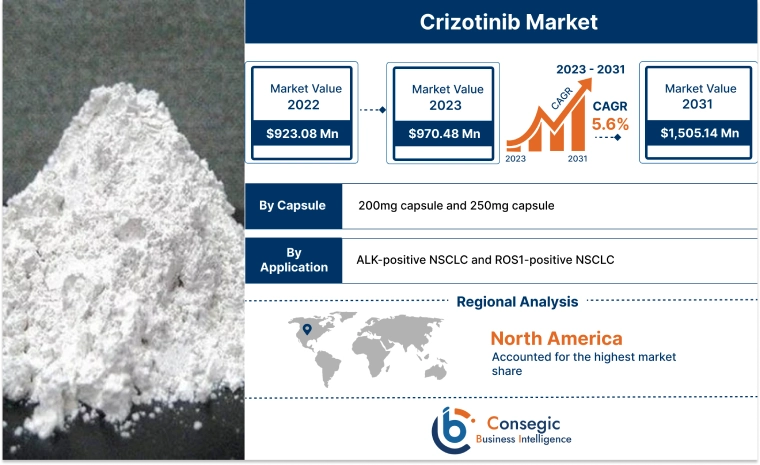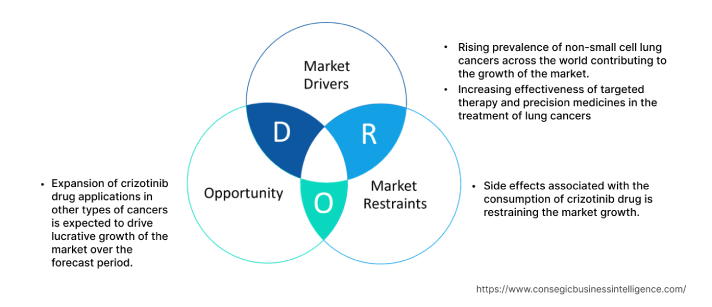- Summary
- Table Of Content
- Methodology
Crizotinib Market Introduction :
Consegic Business Intelligence analyzes that the crizotinib market is growing with a CAGR of 5.6% during the forecast period (2023-2031), and the market is projected to be valued at USD 1,505.14 Million by 2031 and USD 970.48 Million in 2023 from USD 923.08 Million in 2022.
Crizotinib Market Definition & Overview:
Crizotinib is a cancer medication prescribed by doctors for the treatment of lung cancer known as non-small cell lung cancer (NSCLC). This drug slows down the growth of cancer, as it impedes the growth of tumour cells. Crizotinib drug is also called as antineoplastic agent as it intervenes with the growth of cancer cells which are eventually destroyed by the body. This agent is a tyrosine kinase receptor inhibitor, and it belongs to a group of targeted therapy drugs known as cancer growth inhibitors. It can be used if the NSCLC has changes in a gene arrangement called as ALK-positive and ROS1-positive. In addition, crizotinib also stops the growth of dangerous cancer cells by inhibiting further growth of malignant genes from functioning.
The crizotinib drug is an anticancer medicine. This drug is approved by the regulatory body of the United States for the treatment of patients suffering from chronic non-small cell lung cancer. Crizotinib is administered to patients with the aim of stopping the growth of dangerous cancerous cells and further expansion of lethal disease. This drug is mainly administered to patients to inhibit the malignant gene rearrangement rather than to completely cure the disease. Crizotinib is generally taken at home by the prescription of a doctor and is taken on a regular basis as long as it is working and until there are no unwanted side effects by the consumption. Thus, the greater benefits offered by the crizotinib drug for the treatment of non-small cell lung cancer is a prominent factor driving the market growth across the globe.
Crizotinib Market Insights :
Key Drivers :
Rising prevalence of non-small cell lung cancers across the world contributing to the growth of the market
The crizotinib drug is commonly used in the treatment of non-small cell lung cancer. Non-small cell lung cancer is a group of lung cancers consisting of adenocarcinoma, large cell carcinoma, and squamous cell carcinoma, among others. The symptom of this cancer includes shortness of breath, prolonged cough, weight loss, and coughing of blood. This disease is treated with chemotherapy, surgery, immunotherapy, and radiation therapy among others. Additionally, non-small cell lung cancers are controlled by blocking the growth of cancerous cells.
Furthermore, the increase in the prevalence of lung cancer across the world is driving the growth of non-small cell lung cancer. In addition, growing non-small cell lung cancers also influence the demand for crizotinib drugs in the market. For instance, according to the statistics published by the American Society of Clinical Oncology in March 2023, lung cancer is the second most diagnosed cancer worldwide. Non-small cell lung cancers account for 81% of all lung cancers. Thus, the increasing prevalence of non-small cell lung cancer, owing to overall spike in all kinds of lung cancers is the primary factor influencing the growth of the crizotinib market.
Increasing effectiveness of targeted therapy and precision medicines in the treatment of lung cancers
Crizotinib is a popular targeted cancer medicine. It is used in the treatment of advanced non-small cell lung cancers (NSCLC). Targeted drugs are different from chemotherapy treatment. They are more likely to be effective, while chemotherapy fails to have an impact. The objective of precision medicine is to align the right treatments at the right dosages for each individual patient at the right time.
The preference of patients is transitioning towards targeted therapy and precision medicine, owing to their personalized efficiency and effectiveness. For instance, according to the article published by the Journal of Visualized Cancer Medicine in September 2022, targeted therapy has improved 5-year survival rate of lung cancer for past two decades, and precision medicine has played a great role in this progress. Thus, the increased preference for targeted therapies and precision medicines by cancer patients is accelerating the growth of crizotinib market across the globe.
Key Restraints :
Side effects associated with the consumption of crizotinib drug is restraining the market growth
Crizotinib is used in targeted therapies for the treatment of the common lung cancer known as non-small cell lung cancer. However, several side effects associated with the consumption of crizotinib are preventing market growth. This medicine increases the risk of getting infections. Besides that, it also affects the reproducing ability of men and women, owing to the potential for serious harm to an unborn child. Regular side effects associated with crizotinib consist of rigorous vomiting, diarrhea, nausea, appetite loss, fatigue, and visual changes, among several others. Nevertheless, the cancer drug known as alectinib is considered a prominent substitute for the treatment of non-small cell lung cancer. Alectinib has a low toxicity level and side effects compared to crizotinib and it reduces the number of patients discontinuing the treatment. Thus, the low side effects associated with alectinib drug increase its popularity, restraining the growth of crizotinib market.
The reports published by various authorities highlight the side-effects associated with the consumption of crizotinib. For instance, according to the report published by the Electronic Medicines Compendium of the UK in 2020, visual side effects such as blurred vision, double vision, and light sensitiveness are observed in 6 out of 10 people. Thus, the increasing prevalence of side effects and alternative drugs such as alectinib is inhibiting the crizotinib market growth.
Future Opportunities :
Expansion of crizotinib drug applications in other types of cancers is expected to drive lucrative growth of the market over the forecast period
Crizotinib is generally used for the treatment of Alk positive and ROS1-positive non-small cell lung cancer. It is a popular targeted drug known for inhibiting cancer growth. However, several targeted drugs are commonly used in the treatment of advanced breast and stomach cancers. Crizotinib has alterations in MET, ROS1 or ALK. Alterations in these genes are also observed in breast cancer, but are very rare, and not routinely assessed. Most lobular breast cancers lack a protein known as E-cadherin, and crizotinib targets a protein called ROS1 that these cancerous cells depend on, for their growth. Hence, crizotinib can stop the growth of lobular breast cancer cells and augment the development of new products in the market.
Furthermore, crizotinib, being a cancer cell blocker, is expected to be effective in other types of cancers too. For instance, according to the study conducted by the Journal of Medical Oncology in January 2021, crizotinib inhibited growth of MCF7 and T-47D cancer cells in breast cancer. Thus, the expanded applications of targeted drug in breast cancer are expected to create lucrative opportunities in the crizotinib market across the globe.
Crizotinib Market Report Insights :
| Report Attributes | Report Details |
| Study Timeline | 2017-2031 |
| Market Size in 2031 | USD 1,505.14 Million |
| CAGR (2023-2031) | 5.6% |
| By Capsule | 200mg capsule and 250mg capsule |
| By Application | ALK-positive NSCLC and ROS1-positive NSCLC |
| By Region | North America, Europe, Asia-Pacific, Latin America, and Middle East & Africa |
| Key Players | Pfizer, Bulat Pharmaceutical, Beacon Pharmaceuticals PLC, Selleck Chemicals, Incepta Pharmaceuticals Ltd, Shanghai Hope-Chem Co.,Ltd ,WUHAN HANWAYS PHARMCHEM CO., LTD., DEAFARMA, Apothecon Pharmaceuticals Pvt Ltd., LGM Pharma, Hefei Home Sunshine Pharmaceutical Technology Co., Ltd, MANUS AKTTEVA BIOPHARMA LLP, Vea Impex (I) Pvt. Ltd |
Crizotinib Market Segmental Analysis :
Based on the Capsule :
The capsule segment is categorized into 200mg capsule and 250mg capsule. In 2022, the 250mg capsule segment accounted for the highest market share in the crizotinib market and is also expected to grow at the fastest CAGR over the forecast period. The extraordinary growth in the segment is attributed to the higher concentration of 250mg capsule compared to 200mg capsule. As a result, the 250mg capsule is prescribed mostly in adults, owing to its high immunity strength.
Furthermore, adults being more prone to having rigorous smoking habits contributes to the increased possibility of lung cancers. For instance, according to the article published by the Centre for Disease Control and Prevention in 2023, approximately 12 out of 100 adults in the U.S. smoked cigarettes in 2021, accounting for a total of 28.3 million adults in the United States. Hence, most adults having uncontrollable smoking habits influence the rise in the number of lung cancers in adults. Thus, augmenting the spike in non-small cell lung cancer in adults, and therefore propelling the segment growth.
Based on the Application :
The application segment is categorized into ALK-positive NSCLC and ROS1-positive NSCLC. In 2022, the ALK-positive NSCLC segment accounted for the highest market share of 83.79% in the crizotinib market and is also expected to grow at the fastest CAGR over the forecast period. The growth of this segment is contributed to the significant increase in the prevalence of rearrangement of the ALK gene in lung cancer patients. For instance, according to the data published by the Lung Cancer Foundation of America in July 2023, ALK-positive non-small cell lung cancer occurs in 1 out of 25 NSCLC patients, and younger patients generally of age 55 And below, who have never smoked are more likely to be diagnosed with ALK-positive NSCLC.
Furthermore, the presence of ALK-positive gene rearrangements in NSCLC patients is high compared to ROS1-positive gene arrangement. Additionally, no effect of smoking and hazardous environments on the occurrence of ALK-positive NSCLC is augmenting the growth of the segment. For instance, according to the data published by the American lung association in November 2022 approximately 4% patients of lung cancer are ALK-positive and 1-2% are ROS1-positive and these patients are light smokers or never smokers. Thus, the higher prevalence of ALK-positive rearrangements in NSCLC is influencing the growth of this segment.
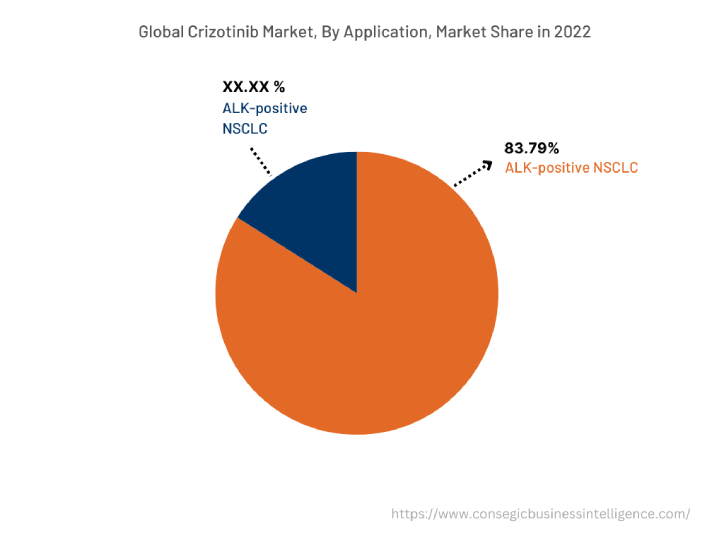
Based on the Region :
The regional segment includes North America, Europe, Asia Pacific, Middle East and Africa, and Latin America..
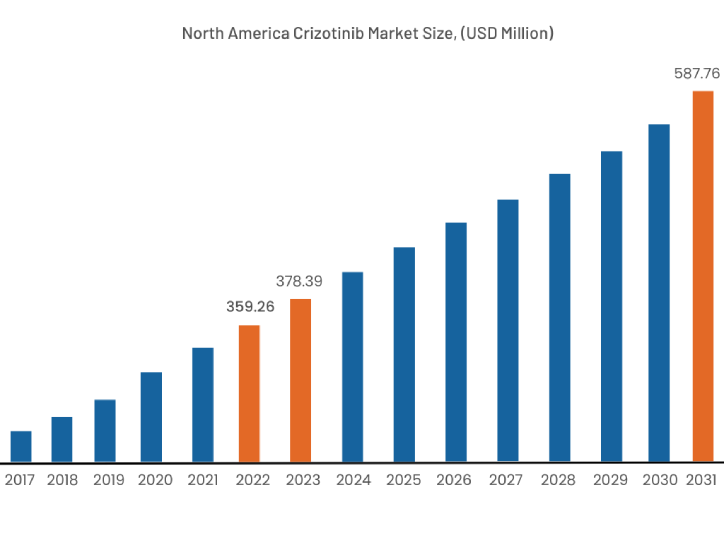
In 2022, North America accounted for the highest market share of 38.92% valued at USD 359.26 Million in 2022 and USD 378.39 Million in 2023 and is expected to reach USD 587.76 Million in 2031. In the North American region, the U.S. accounted for the highest market share of 64.10% in 2022. The growth of the crizotinib market in North American countries is attributed to the increased exposure of the population to hazardous working environments. Additionally, an increased preference for precision medicine and targeted therapy is also driving the growth crizotininb market in North American region.
Moreover, the Asia Pacific region is expected to grow at the fastest CAGR of 6.1% during the forecast period. The growth in this region is attributed to increasing number of household incomes across Asian countries. The augmented income level of families in the region contributes to the rising preference for advanced and better diagnostic procedures. Thus, contributing to the increase in `the diagnosis of lung cancers more often, and fueling the growth of crizotinib market in the region.
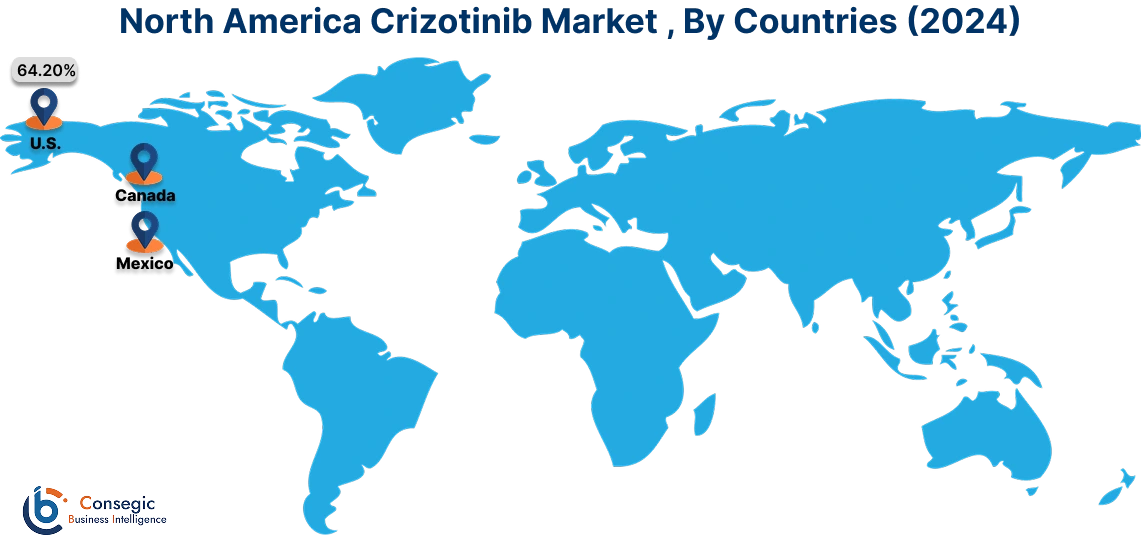
Top Key Players & Market Share Insights:
The Crizotinib market is highly competitive, with several large players and numerous small and medium-sized enterprises. These companies have strong research and development capabilities and a strong presence in the market through their extensive product portfolios and distribution networks. The market is characterized by intense competition, with companies focusing on expanding their product offerings and increasing their market share through mergers, acquisitions, and partnerships. The key players in the market include-
- Pfizer
- Bulat Pharmaceutical
- LGM Pharma
- Hefei Home Sunshine Pharmaceutical Technology Co., Ltd
- MANUS AKTTEVA BIOPHARMA LLP
- Vea Impex (I) Pvt. Ltd
- Beacon Pharmaceuticals PLC
- Selleck Chemicals
- Incepta Pharmaceuticals Ltd
- Shanghai Hope-Chem Co.,Ltd
- WUHAN HANWAYS PHARMCHEM CO., LTD.
- DEAFARMA
- Apothecon Pharmaceuticals Pvt Ltd.
Recent Industry Developments :
- In September 2022, the European Medicines Agency's (EMA's) Committee for Medicinal Products for Human Use (CHMP) approved 2 new suggestions, recommending crizotinib product of Pfizer for the treatment of paediatric patients with anaplastic large cell lymphoma (ALCL) or inflammatory myofibroblastic tumour (IMT).
- In September 2023, the FDA approved the new formulation of Pfizer's crizotinib product Xalkori in form of oral pellet. Xalkori was previously authorized as an oral capsule.
Key Questions Answered in the Report
What was the market size of the crizotinib market in 2022? +
In 2022, the market size of crizotinib was USD 923.08 million.
What will be the potential market valuation for the crizotinib market by 2031? +
In 2031, the market size of crizotinib is expected to reach USD 1,505.14 million.
What are the key factors driving the growth of the crizotinib market? +
Side effects associated with the consumption of crizotinib drug is one of the major factors restricting the market growth.
What is the dominating segment in the crizotinib market by capsule? +
In 2022, the 250mg capsule segment accounted for the highest market share in the overall crizotinib market.
Based on current market trends and future predictions, which geographical region will have the fastest impact on the crizotinib market's growth in the coming years? +
Asia Pacific is expected to be the fastest-growing region in the market during the forecast period.
